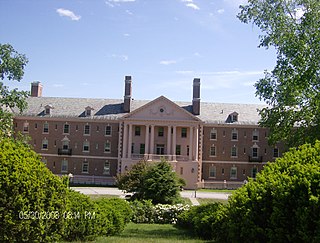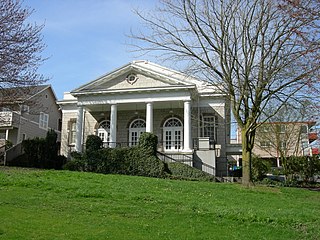
The First Church of Christ, Scientist is the administrative headquarters and mother church of the Church of Christ, Scientist, also known as the Christian Science church. Christian Science was founded in the 19th century in Lynn, Massachusetts, by Mary Baker Eddy with the publication of her book Science and Health (1875).

First Church of Christ, Scientist, also known as First Christian Science Church Edifice, is a church building located in Oconto, Wisconsin. Built in 1886 of stone, weatherboard and brick in the Gothic Revival style, it was the first purpose-built Christian Science church edifice in the world. It was added to the National Register of Historic Places in 1974.

The First Church of Christ, Scientist building in Minneapolis, Minnesota, was the first of its kind in the state.

The former First Church of Christ, Scientist, built in 1939, is an historic Classical revival style Christian Science church edifice located at 501 Riverside Drive, overlooking the Truckee River in Reno, Nevada. Anna Frandsen Loomis, a wealthy local Christian Scientist, underwrote the $120,000 cost of the building, including land acquisition and architect's fees. She was responsible for hiring noted Los Angeles architect Paul Revere Williams, the first African-American member of the AIA. In 1998 the congregation sold the building and used the funds from the sale to construct a new church at 795 West Peckham Lane. Church member and local theater patron Moya Lear donated $1.1 million to the Reno-Sparks Theater Community Coalition, which used the funding to purchase the First Church of Christ, Scientist and renamed it the Lear Theater.

The Pleasant View Home is an historic senior citizen residential facility located at 227 Pleasant Street in Concord, New Hampshire, in the United States. On September 19, 1984, it was added to the National Register of Historic Places.

Iglesia La Luz del Mundo is a historic church located in Salt Lake City, Utah, United States. Originally built as the First Church of Christ, Scientist, on July 30, 1976 it was added to the National Register of Historic Places.

The former First Church of Christ, Scientist, built in 1940, is an historic Christian Science church building located at 391 Walnut Street on the corner of Otis Street in the village of Newtonville, in Newton, Massachusetts. It was designed in the redbrick Colonial Revival style by Densmore, LeClear and Robbins, architects. Due to cost constraints, its steeple was added later. In September, 2004, the church sold its building for $1,050,000 to be converted into apartments. The church in 2007 held services in rented rooms at 300 Walnut Street in the Masonic Building., but is now meeting at 1141 Walnut Street, in Newton Highlands. The building has since been divided into 11 condominium units. It is now called the Oxford House, and was the city's first inclusionary zoning project.
The former First Church of Christ, Scientist, built in 1922, is an historic Classical Revival style Christian Science church located at 15422 Detroit Avenue, on the northeast corner of Detroit and Arthur avenues, across from the Public Library in Lakewood, Ohio. Its massive entrance portico is supported by six Doric columns. It was designed by noted Chicago-based architect Charles Draper Faulkner, who was renowned for the churches and other buildings that he designed in the United States and Japan. He designed over 33 Christian Science church buildings and wrote a book called Christian Science Church Edifices which features this church as well as many others.

First Church of Christ, Scientist is the main congregation for Atlanta, Georgia’s Christian Science community. Its historic Greek revival church edifice is located on the corner of Fifteenth Street, N.E., and Peachtree Street in the city's Midtown section and is a contributing property in the Ansley Park Historic District.

Queen Anne Boulevard is a 6.0-kilometre (3.7 mi) loop atop Seattle, Washington's Queen Anne Hill. It is a City of Seattle landmark. Authorized in 1907 and built from 1911 to 1916, it incorporates parts of 5th, 7th, 8th and 10th Avenues West; Bigelow Avenue North; West Blaine, McGraw, Wheeler, Fulton and Raye Streets; Smith, McGraw, and Wheeler Streets; West Highland Drive; and West McGraw and McGraw Places.

The former First Church of Christ, Scientist, built in 1912, is a historic Christian Science church edifice located at 1366 South Alvarado Street in Pico-Union, Los Angeles, California.

The former First Church of Christ, Scientist, built in 1916 in the Classical Revival style, is a historic Christian Science church edifice located at 132 E. 4th Street in Neillsville, Wisconsin. It was designed in the form of a Greek cross by Chicago architect L. J. Corbey for Christian Science Society, Neillsville, which had been organized in January, 1912 and which later became First Church of Christ, Scientist. Its front portico is supported by four large Tuscan columns. While small in size, the building projects a large presence. Its auditorium windows are of green opalescent art glass. On March 31, 2003, it was added to the National Register of Historic Places.

The former Fifth Church of Christ, Scientist, located at 3515 South Alaska Street in the Columbia City neighborhood in the Rainier Valley area of Seattle, Washington, is an historic Christian Science church edifice, whose original entrance was on 36th Avenue. South. Built in 1921. was designed by Earl A. Roberts in the Greek Revival and Neo-Palladian styles. It is a contributing property in the Columbia City Historic District, which was added to the National Register of Historic Places on September 8, 1980. Fifth Church is no longer in existence. The building is now the Rainier Arts Center. The only major exterior change made by the center was the relocation of the front entrance to Alaska Street.

Third Church of Christ, Scientist, established in 1918, is a Christian Science church in downtown Washington, D.C. From 1971 to 2014, the church was located in a controversial building at 16th and I Street NW. Considered a significant work of "Brutalist" church architecture by some critics, the building was considered unsatisfactory by members of the Church's congregation, which shrank over the years. In 2007, the church applied for a demolition permit for the building to permit sale and redevelopment of the site, with plans to relocate to a more suitable structure. A 1991 application for landmark status for the building, filed to forestall a demolition threat then, was subsequently approved. After a lawsuit and hearings, the District of Columbia issued a demolition permit in May 2009, and the building was demolished in 2014. In 2015, Third Church merged with First Church of Christ, Scientist. The congregation continues as First Church and conducts its activities in a portion of the new building.

The former First Church of Christ Scientist, is an historic Christian Science church building located at 315 Wisconsin Avenue, Madison, Wisconsin, United States. Built in 1929, it was designed in the Classical Revival-style by noted Madison architect Frank M. Riley. In 1982 the building was added to the National Register of Historic Places.

The Former Free Will Baptist Church is a historic church building at 12 High Street in Milo, Maine. It is home to the Milo Historical Society Museum. Built in 1853, this wood-frame structure was Milo's first church, shared initially by Baptist and Free Will Baptist congregations before becoming the exclusive property of the latter. It has served as the local history museum since 1996. The building was listed on the National Register of Historic Places in 2000.

Sanctuary at Admiral, also known as Sixth Church of Christ, Scientist, is an historic church edifice which has been converted to a venue for weddings and banquets and is located at 2656 42nd Avenue, Southwest, in the Admiral District of West Seattle in Seattle, Washington.

The 27th Street Historic District is a historic district in the South Los Angeles area of Los Angeles, California. The district was listed on the National Register of Historic Places in 2009 as part of the multiple property submission for African Americans in Los Angeles.





















